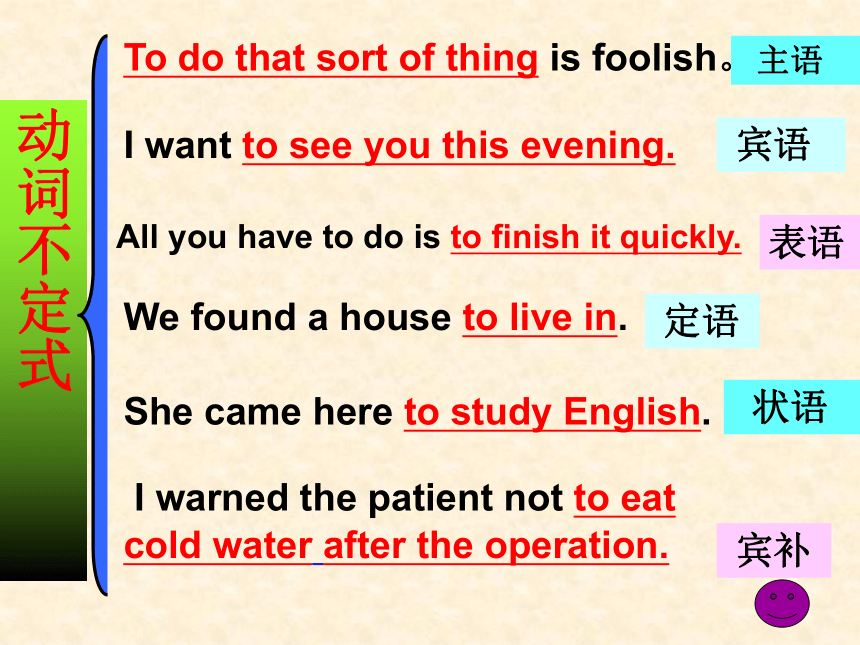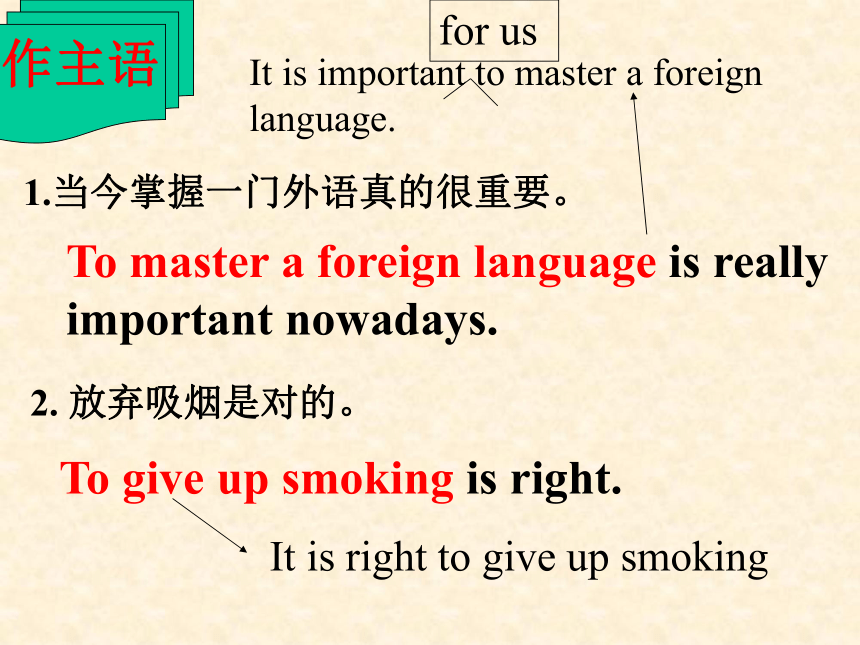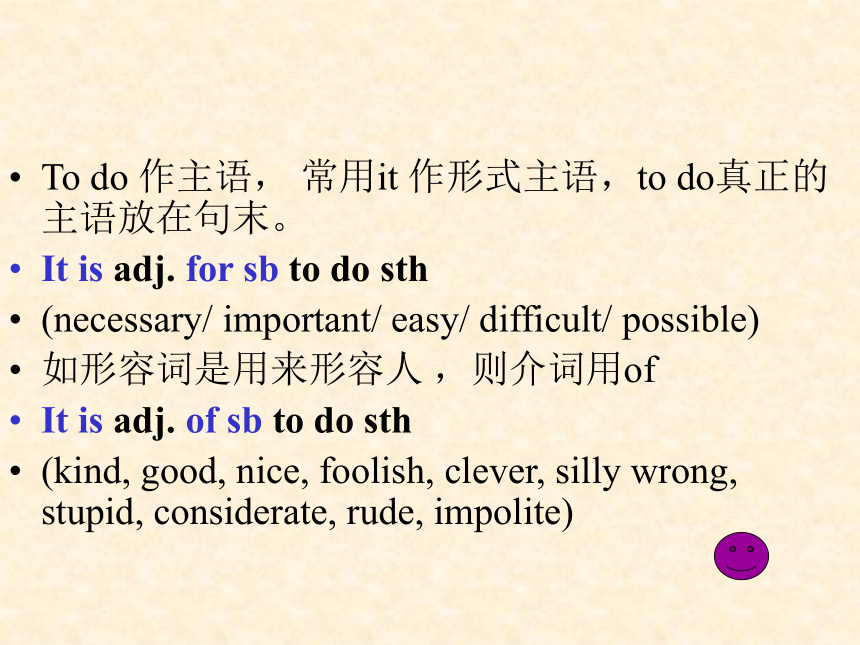Unit 3 Sea Exploration grammar动词不定式(共50张PPT)
文档属性
| 名称 | Unit 3 Sea Exploration grammar动词不定式(共50张PPT) |  | |
| 格式 | zip | ||
| 文件大小 | 1.9MB | ||
| 资源类型 | 教案 | ||
| 版本资源 | 人教版(2019) | ||
| 科目 | 英语 | ||
| 更新时间 | 2022-11-28 09:10:46 | ||
图片预览












文档简介
(共50张PPT)
Grammar: infinitives
动词不定式
动词不定式属于非谓语动词的一种形式,区别于谓语动词。
一、动词不定式在句子中不能充当谓语,没有人称和数的变化。
二、动词不定式是由“to+动词原形”构成(有时可以不带to)。
动词不定式的否定形式是“not+动词不定式” 。
动词不定式
To do that sort of thing is foolish。
I want to see you this evening.
All you have to do is to finish it quickly.
We found a house to live in.
She came here to study English.
I warned the patient not to eat cold water after the operation.
主语
宾语
表语
定语
状语
宾补
作主语作宾语作定语作表语作宾补作状语动词不定式1.动词不定式作主语动词不定式作主语,谓语动词用第三人称单数。To get there by carwill takea whole day.How to get enough moneyisstill a question.
动名词作主语通常表示抽象动作;而不定式作主语表示具体动作。
Smoking is prohibited here.这里禁止抽烟。(抽象)
To smoke so much is not very good for you .你抽这么多烟对你身体很不好。(具体)
作主语
To master a foreign language is really important nowadays.
To give up smoking is right.
1.当今掌握一门外语真的很重要。
2. 放弃吸烟是对的。
It is important to master a foreign language.
It is right to give up smoking
for us
To do 作主语, 常用it 作形式主语,to do真正的主语放在句末。
It is adj. for sb to do sth
(necessary/ important/ easy/ difficult/ possible)
如形容词是用来形容人 ,则介词用of
It is adj. of sb to do sth
(kind, good, nice, foolish, clever, silly wrong, stupid, considerate, rude, impolite)
2.动词不定式作表语1.主语和表语都是不定式(其含义往往一是条件,一是结果),如:To be kind to the enemy is to be cruel to the people.To do that would be to cut the foot to fit the shoe.2.主语是以aim, duty, hope, idea, intention, mistake, plan, proposal, job, suggestion等为中心词的名词词组,或以what引导的名词性从句表示,表语用不定式说明其内容,如:My idea isto climb the mountain from the north.My suggestion isto start work at once.What I would suggest isto start work at once.注:在某些句型中,当主语部分有动作动词do时,作表语的不定式可以省略符号 “to”,如:All we have to do ispush the button.The only thing I can do now isgo on by myself.All I could do wassend him a telegram.
作宾语
Fred didn’t have any money, so he decided to look for a job.
He promised not to tell anyone about it.
1. Fred 没有钱,所以他决定找一份工作。
2. 他答应不告述任何人这事。
一. 通常要用动词不定式做宾语的动词有:wish , hope , prepare, manage , ask , offer , promise , expect, pretend , decide, intend等。
巧记动词不定式作宾语歌诀:
想要拒绝莫忘记
(want, refuse, forget)
需要努力就学习
(need, try, learn)
喜欢帮助加同意
(like help agree )
希望决定后开始
(hope, decide, begin, start)
二. 有时可以用 it 作形式宾语,而把真正作宾语的动词不定式放在后面。
It is + adj. (of / for sb) to do sth
例如: I find it hard to persuade her.
常用动词: make, find, feel, think, believe, consider
He made it a rule to read English every day.
I find it hard for me to master a foreign language.
三. 有些动词后面既可以接不定式作宾语,又接动名词作宾语,但意义不同。如remember, forget, stop, try, regret, mean 等。
例如:
I remember locking the door.
( lock 动作已经发生)
Please remember to lock the door when you leave.
( lock 动作还没有发生)
后面只接动名词做宾语的动词
实践完成听建议
practice finish suggest
习惯继续别放弃
be used to keep on give up
喜欢思念忙介意
enjoy miss be busy mind
不禁考虑会想你
can’t help consider feel like
2) 思考: 巧记哪些动名词与不定式的动词意思有较大的区别?
记住要努力,(remember want try )
需要别忘记; (need forget )
后悔没尽力, ( regret try )
意思要停止。 ( mean require stop )
返回
1. remember to do sth 记住要做某事
You must remember to lock the door when you leave
2. remember doing sth 记得曾做过某事
I remember locking the front door
3. forget to do sth 忘记要做某事
He forgot to do his homework yesterday
4. forget doing sth 忘记曾做过某事
I forgot saying this thing to you
5. try to do sth 努力做某事
He tries to answer each question
6. try doing sth 试着做某事
I tried singing an English song
7. mean to do sth 打算做某事
We mean to travel abroad next year
我们明年打算去国外旅行
8. mean doing sth 意味着
It means waiting for him another hour
这意味着要再等一个小时
9. stop to do sth 停下来去做另一件事
Stop to have a rest if you are tired
10. stop doing sth 停止做某事
Although it rained heavily , the farmers didn’t stop working in the field 虽然雨下得很大,农民们却没有停止在田间劳动
11. regret to do sth 对现在发生的事表示“遗憾”
We regret to inform you that you owe the bank $ 100
我们很遗憾地通知你,你欠银行100美元
12. regret doing sth 对发生过的事表示“后悔”
He regretted playing computer games.他后悔玩电脑游戏
13. go on to do sth
做完一件事后继续做另外一件不同的事
14. go on doing sth继续做原来所做的同一件事
你记得哪一条路到那儿吗?
Do you remember which way to get
there
下一步干什么你决定了吗
Have you decided what to do next
我来问他怎么样开这机器。
I’ll ask him how to operate the
machine.
1) 不定式有时和连接代词/副词构成宾语。
2) 有时不定式由whether引起。
I didn’t know whether to laugh or cry
about it.
3) feel, find, judge, make, think, believe,
consider 等动词后如果是不定式做宾语,
补语是形容词(间或是名词),常用it作形
式宾语,把不定式后移。
I find it difficult to work with him.
4. 作定语
不定式放在被修饰的名词、代词后面,往往
表示未发生的动作。
I have a lot of work to do.
She is the first student to come to school.
I have some books for you to read.
She is looking for a room to live in.
There is nothing to worry about.
4.作定语
动词不定式作定语时,应放在被修饰词的后面。
动词不定式作定语的几种情况:
(1)序数词、形容词最高级或 the last/the only/the next 等后或被这些词修饰的名词后常用动词不定式作定语。
He is the best man to do the job.
他是做这项工作的最佳人选。
He is always the first to come and the last to leave.
他总是第一个来,最后一个走。
(2)抽象名词time,way,reason,chance,opportunity,ability,promise,attempt等后常用动词不定式作定语。
Interest is as vital to learning as the ability to understand,even more so.
对于学习来说,兴趣同理解能力一样重要,甚至更重要。
He made a promise to come here on time tomorrow.
他许诺明天按时来这儿。
(3)something,nothing,anything等不定代词后常用动词不定式作定语。
Do you have anything to say
你有什么要说的吗?
(4)在there be句型中,作主语的名词后可接动词不定式作定语,不定式用主动式或被动式均可,一般用主动形式表示被动意义。
There is nothing to worry/to be worried about.
没什么可担心的。
作定语
a. 动词不定式可以用在名词后面作定语。
如:I have many letters to answer.
b. 但如果动词不定式的动词为不及物动词时,要在其后面加上适当的介词。
如:She has only a cold room to live in.
练习:
一张供写的纸
一把坐的椅子
a piece of paper to write on
a chair to sit on
4.动词不定式作定语注意:动词不定式作定语,它与所修饰的名词或代词可能是主谓关系,也可能是动宾关系。如果是动宾关系,不定式主动表示被动。He was the last one to leave school yesterday.We have much homework to do everyday.
作状语
He spoke loudly (so as / in order) to be heard.
They jumped with joy to hear the news.
I’m too tired to walk any further tonight.
They hurried to the station only to find that the train had left.
目的状语.
原因状语.
结果状语
有时为了加强语气,不定式可以提前到句首,但是 so as to 不能放在句首。
5. 作状语
目的状语: 常用的结构—to do; in order to do, so as to do, so/ such …as to do, etc.
I come here to say good-bye to you.
不定式结构表示结果更常见于下列句型:
① so …as to …
Would you be so kind as to lend me your bicycle / tell me the time
② such (…) as to …
I’m not such a fool as to believe that.
③ enough to …
The boy is old enough to go to school.
④ too … to …
★only to do表示一种意想不到的结果
Eg:We went to the train station only to find that the train had left.
[区别] 现在分词(短语)作结果状语多表示顺其自然的结果,不定式做结果状语表示出乎意料结果。
Jack has made great progress,making his parents very happy.
杰克取得了巨大的进步,这让他的父母很高兴。
He got to the station only to be told the train had gone.
他到了车站,却被告知火车已经开走了。
当too前有only时,only too …to…译作肯定。I am only too pleased to help you.当不定式前有表否定意义的词时,译作肯定。We are never too old to learn.
原因状语: 一般用在句尾,用来说明产生某种情绪
或作出某种评价的原因。跟在情绪类词后:
happy,lucky,surprised,sorry,glad,
delighted,eager,anxious,ready,foolish,
interested,careless等
I’m glad to see you.
She wept to see the sight.
作宾补
She asked me to stay there.
1. 她叫我呆在这儿。
2.请允许我介绍Mr. White给你们。
Please allow me to introduce Mr. White to you.
可以用动词不定式做宾补的动词有: advise , ask , allow , expect , encourage , force , permit , order , persuade , request , tell , want , wish 等。
有些动词后面的不定式作宾补时,不带to,如
(感官类)
feel, hear, listen to, see, watch, notice, observe .
(使役动词)
make, have, let,
变成被动句,需还原to: He was made to wear a mask.
I heard them sing a pop song .
The teacher made me answer the question.
We watched them play football .
动词不定式的时态
1. I opened the door to enter the room.
2. Mr. Smith is going to attend the meeting to be held tomorrow.
㈠. 一般式( to do ).
不定式的一般式所表示的动作(状态)同时(或几乎同时)发生,或之后发生。
㈡.进行式( to be doing)
1. I am very glad to be working with you.
2. Be quiet! They seem to be having class.
如果谓语表示的动作(情况)发生时,不定式所表示的动作正在进行。
动词不定式的时态
动词不定式的时态
㈢.完成式(to have done)
1. I am sorry to have kept you waiting so long.
2. You seemed to have read the novel written by Mr. Smith.
如果谓语表示的动作发生在不定式之前。
动词不定式的语态
㈠.主动式( to do / to be doing /to have done)
1. We want to learn English well.
2.Robert is said____abroad, but I didn’t know what country he studied in.(NMET99)
to have studied B.to study
C. made D. to make
当不定式逻辑上的主语是不定式所表示的动作的执行者时.
动词不定式的语态
㈡.被动式( to be done / to have been done)
1. He didn’t like to be laughed at.
2. He claimed ____in the supper market when he was doing shopping yesterday.(上海98)
being badly treated B.treating badly
C. to be treated badly D. to have been badly treated.
当不定式逻辑上的主语是不定式所表示的动作的承受者时.
动词不定式的主动形式表示被动意义
(1)动词不定式作定语与被修饰词构成动宾关系,同时与句中另一名词或代词有逻辑上的主谓关系时。
We have masses of work to do today.Hurry up!
今天,我们有很多工作要做。快点儿!
(2)在“主语+be+性质形容词+动词不定式”结构中。
The license is difficult to get.许可证很难得到。
注意:此结构中,to后的动词往往和主语有逻辑上的动宾关系。
(3)动词不定式与疑问代词连用时。
What to do next hasn’t been decided.
下一步该做什么还没有决定。
I wonder which to choose next.
我想知道下一步选哪一个。
(4)在“be to blame”中常用主动形式表示被动意义。
I felt I was to blame for this bicycle accident.
我觉得这次自行车事故怪我。
注意
A. 动词不定式的否定式只须在to 前加 not.
My father decided not to take up the job.
The teacher told us not to be late again.
To do
一般式 to do 被动 to be done
完成式 to have done to have been done
进行式 to be doing
否定式 not to do
逻辑主语 for sb to do sth
of sb to do sth
注意
B. 作简短回答或避免不必要的重复时,动词不定式常常省去to 后面的动词,只保留to 。
A:Would you like to come to my party
Mary wanted to use my bike, but I asked her not to ( use my bike).
B: Yes , I’d love to ( come to your party).
Mary想用我的自行车,但我叫她别用。
1.在使役动词 have, let, make 之后。
2.在感官动词 feel, hear, see, watch, notice, observe, listen to, look at 之后。
3.在 why 和 why not 之后。
4. 在其他结构之中。
a. can do nothing but / except do
have nothing to do but/ except wait
have no choice but to wait
b. cannot help but do
c. cannot but do
d. had better do sth
e. would rather do sth f. help sb do sth
小结(省略to的情况)
(一感二听三让四看半帮助,主动不to 被动to)
C. 不定式、过去分词和现在分词作定语的区别
这三种形式作定语,体现在动作的发生时间上。
过去分词作定语表示被动和完成。如:
Have you read the novel written by dickens
The developed country
现在分词作定语表示正在进行。如:
The flying kites are high in the sky.
The developing country
不定式的被动式作定语时,表示将来的动作。如:
The question to be discussed at the
tomorrow’s meeting is a very important one.
Goodbye!
Grammar: infinitives
动词不定式
动词不定式属于非谓语动词的一种形式,区别于谓语动词。
一、动词不定式在句子中不能充当谓语,没有人称和数的变化。
二、动词不定式是由“to+动词原形”构成(有时可以不带to)。
动词不定式的否定形式是“not+动词不定式” 。
动词不定式
To do that sort of thing is foolish。
I want to see you this evening.
All you have to do is to finish it quickly.
We found a house to live in.
She came here to study English.
I warned the patient not to eat cold water after the operation.
主语
宾语
表语
定语
状语
宾补
作主语作宾语作定语作表语作宾补作状语动词不定式1.动词不定式作主语动词不定式作主语,谓语动词用第三人称单数。To get there by carwill takea whole day.How to get enough moneyisstill a question.
动名词作主语通常表示抽象动作;而不定式作主语表示具体动作。
Smoking is prohibited here.这里禁止抽烟。(抽象)
To smoke so much is not very good for you .你抽这么多烟对你身体很不好。(具体)
作主语
To master a foreign language is really important nowadays.
To give up smoking is right.
1.当今掌握一门外语真的很重要。
2. 放弃吸烟是对的。
It is important to master a foreign language.
It is right to give up smoking
for us
To do 作主语, 常用it 作形式主语,to do真正的主语放在句末。
It is adj. for sb to do sth
(necessary/ important/ easy/ difficult/ possible)
如形容词是用来形容人 ,则介词用of
It is adj. of sb to do sth
(kind, good, nice, foolish, clever, silly wrong, stupid, considerate, rude, impolite)
2.动词不定式作表语1.主语和表语都是不定式(其含义往往一是条件,一是结果),如:To be kind to the enemy is to be cruel to the people.To do that would be to cut the foot to fit the shoe.2.主语是以aim, duty, hope, idea, intention, mistake, plan, proposal, job, suggestion等为中心词的名词词组,或以what引导的名词性从句表示,表语用不定式说明其内容,如:My idea isto climb the mountain from the north.My suggestion isto start work at once.What I would suggest isto start work at once.注:在某些句型中,当主语部分有动作动词do时,作表语的不定式可以省略符号 “to”,如:All we have to do ispush the button.The only thing I can do now isgo on by myself.All I could do wassend him a telegram.
作宾语
Fred didn’t have any money, so he decided to look for a job.
He promised not to tell anyone about it.
1. Fred 没有钱,所以他决定找一份工作。
2. 他答应不告述任何人这事。
一. 通常要用动词不定式做宾语的动词有:wish , hope , prepare, manage , ask , offer , promise , expect, pretend , decide, intend等。
巧记动词不定式作宾语歌诀:
想要拒绝莫忘记
(want, refuse, forget)
需要努力就学习
(need, try, learn)
喜欢帮助加同意
(like help agree )
希望决定后开始
(hope, decide, begin, start)
二. 有时可以用 it 作形式宾语,而把真正作宾语的动词不定式放在后面。
It is + adj. (of / for sb) to do sth
例如: I find it hard to persuade her.
常用动词: make, find, feel, think, believe, consider
He made it a rule to read English every day.
I find it hard for me to master a foreign language.
三. 有些动词后面既可以接不定式作宾语,又接动名词作宾语,但意义不同。如remember, forget, stop, try, regret, mean 等。
例如:
I remember locking the door.
( lock 动作已经发生)
Please remember to lock the door when you leave.
( lock 动作还没有发生)
后面只接动名词做宾语的动词
实践完成听建议
practice finish suggest
习惯继续别放弃
be used to keep on give up
喜欢思念忙介意
enjoy miss be busy mind
不禁考虑会想你
can’t help consider feel like
2) 思考: 巧记哪些动名词与不定式的动词意思有较大的区别?
记住要努力,(remember want try )
需要别忘记; (need forget )
后悔没尽力, ( regret try )
意思要停止。 ( mean require stop )
返回
1. remember to do sth 记住要做某事
You must remember to lock the door when you leave
2. remember doing sth 记得曾做过某事
I remember locking the front door
3. forget to do sth 忘记要做某事
He forgot to do his homework yesterday
4. forget doing sth 忘记曾做过某事
I forgot saying this thing to you
5. try to do sth 努力做某事
He tries to answer each question
6. try doing sth 试着做某事
I tried singing an English song
7. mean to do sth 打算做某事
We mean to travel abroad next year
我们明年打算去国外旅行
8. mean doing sth 意味着
It means waiting for him another hour
这意味着要再等一个小时
9. stop to do sth 停下来去做另一件事
Stop to have a rest if you are tired
10. stop doing sth 停止做某事
Although it rained heavily , the farmers didn’t stop working in the field 虽然雨下得很大,农民们却没有停止在田间劳动
11. regret to do sth 对现在发生的事表示“遗憾”
We regret to inform you that you owe the bank $ 100
我们很遗憾地通知你,你欠银行100美元
12. regret doing sth 对发生过的事表示“后悔”
He regretted playing computer games.他后悔玩电脑游戏
13. go on to do sth
做完一件事后继续做另外一件不同的事
14. go on doing sth继续做原来所做的同一件事
你记得哪一条路到那儿吗?
Do you remember which way to get
there
下一步干什么你决定了吗
Have you decided what to do next
我来问他怎么样开这机器。
I’ll ask him how to operate the
machine.
1) 不定式有时和连接代词/副词构成宾语。
2) 有时不定式由whether引起。
I didn’t know whether to laugh or cry
about it.
3) feel, find, judge, make, think, believe,
consider 等动词后如果是不定式做宾语,
补语是形容词(间或是名词),常用it作形
式宾语,把不定式后移。
I find it difficult to work with him.
4. 作定语
不定式放在被修饰的名词、代词后面,往往
表示未发生的动作。
I have a lot of work to do.
She is the first student to come to school.
I have some books for you to read.
She is looking for a room to live in.
There is nothing to worry about.
4.作定语
动词不定式作定语时,应放在被修饰词的后面。
动词不定式作定语的几种情况:
(1)序数词、形容词最高级或 the last/the only/the next 等后或被这些词修饰的名词后常用动词不定式作定语。
He is the best man to do the job.
他是做这项工作的最佳人选。
He is always the first to come and the last to leave.
他总是第一个来,最后一个走。
(2)抽象名词time,way,reason,chance,opportunity,ability,promise,attempt等后常用动词不定式作定语。
Interest is as vital to learning as the ability to understand,even more so.
对于学习来说,兴趣同理解能力一样重要,甚至更重要。
He made a promise to come here on time tomorrow.
他许诺明天按时来这儿。
(3)something,nothing,anything等不定代词后常用动词不定式作定语。
Do you have anything to say
你有什么要说的吗?
(4)在there be句型中,作主语的名词后可接动词不定式作定语,不定式用主动式或被动式均可,一般用主动形式表示被动意义。
There is nothing to worry/to be worried about.
没什么可担心的。
作定语
a. 动词不定式可以用在名词后面作定语。
如:I have many letters to answer.
b. 但如果动词不定式的动词为不及物动词时,要在其后面加上适当的介词。
如:She has only a cold room to live in.
练习:
一张供写的纸
一把坐的椅子
a piece of paper to write on
a chair to sit on
4.动词不定式作定语注意:动词不定式作定语,它与所修饰的名词或代词可能是主谓关系,也可能是动宾关系。如果是动宾关系,不定式主动表示被动。He was the last one to leave school yesterday.We have much homework to do everyday.
作状语
He spoke loudly (so as / in order) to be heard.
They jumped with joy to hear the news.
I’m too tired to walk any further tonight.
They hurried to the station only to find that the train had left.
目的状语.
原因状语.
结果状语
有时为了加强语气,不定式可以提前到句首,但是 so as to 不能放在句首。
5. 作状语
目的状语: 常用的结构—to do; in order to do, so as to do, so/ such …as to do, etc.
I come here to say good-bye to you.
不定式结构表示结果更常见于下列句型:
① so …as to …
Would you be so kind as to lend me your bicycle / tell me the time
② such (…) as to …
I’m not such a fool as to believe that.
③ enough to …
The boy is old enough to go to school.
④ too … to …
★only to do表示一种意想不到的结果
Eg:We went to the train station only to find that the train had left.
[区别] 现在分词(短语)作结果状语多表示顺其自然的结果,不定式做结果状语表示出乎意料结果。
Jack has made great progress,making his parents very happy.
杰克取得了巨大的进步,这让他的父母很高兴。
He got to the station only to be told the train had gone.
他到了车站,却被告知火车已经开走了。
当too前有only时,only too …to…译作肯定。I am only too pleased to help you.当不定式前有表否定意义的词时,译作肯定。We are never too old to learn.
原因状语: 一般用在句尾,用来说明产生某种情绪
或作出某种评价的原因。跟在情绪类词后:
happy,lucky,surprised,sorry,glad,
delighted,eager,anxious,ready,foolish,
interested,careless等
I’m glad to see you.
She wept to see the sight.
作宾补
She asked me to stay there.
1. 她叫我呆在这儿。
2.请允许我介绍Mr. White给你们。
Please allow me to introduce Mr. White to you.
可以用动词不定式做宾补的动词有: advise , ask , allow , expect , encourage , force , permit , order , persuade , request , tell , want , wish 等。
有些动词后面的不定式作宾补时,不带to,如
(感官类)
feel, hear, listen to, see, watch, notice, observe .
(使役动词)
make, have, let,
变成被动句,需还原to: He was made to wear a mask.
I heard them sing a pop song .
The teacher made me answer the question.
We watched them play football .
动词不定式的时态
1. I opened the door to enter the room.
2. Mr. Smith is going to attend the meeting to be held tomorrow.
㈠. 一般式( to do ).
不定式的一般式所表示的动作(状态)同时(或几乎同时)发生,或之后发生。
㈡.进行式( to be doing)
1. I am very glad to be working with you.
2. Be quiet! They seem to be having class.
如果谓语表示的动作(情况)发生时,不定式所表示的动作正在进行。
动词不定式的时态
动词不定式的时态
㈢.完成式(to have done)
1. I am sorry to have kept you waiting so long.
2. You seemed to have read the novel written by Mr. Smith.
如果谓语表示的动作发生在不定式之前。
动词不定式的语态
㈠.主动式( to do / to be doing /to have done)
1. We want to learn English well.
2.Robert is said____abroad, but I didn’t know what country he studied in.(NMET99)
to have studied B.to study
C. made D. to make
当不定式逻辑上的主语是不定式所表示的动作的执行者时.
动词不定式的语态
㈡.被动式( to be done / to have been done)
1. He didn’t like to be laughed at.
2. He claimed ____in the supper market when he was doing shopping yesterday.(上海98)
being badly treated B.treating badly
C. to be treated badly D. to have been badly treated.
当不定式逻辑上的主语是不定式所表示的动作的承受者时.
动词不定式的主动形式表示被动意义
(1)动词不定式作定语与被修饰词构成动宾关系,同时与句中另一名词或代词有逻辑上的主谓关系时。
We have masses of work to do today.Hurry up!
今天,我们有很多工作要做。快点儿!
(2)在“主语+be+性质形容词+动词不定式”结构中。
The license is difficult to get.许可证很难得到。
注意:此结构中,to后的动词往往和主语有逻辑上的动宾关系。
(3)动词不定式与疑问代词连用时。
What to do next hasn’t been decided.
下一步该做什么还没有决定。
I wonder which to choose next.
我想知道下一步选哪一个。
(4)在“be to blame”中常用主动形式表示被动意义。
I felt I was to blame for this bicycle accident.
我觉得这次自行车事故怪我。
注意
A. 动词不定式的否定式只须在to 前加 not.
My father decided not to take up the job.
The teacher told us not to be late again.
To do
一般式 to do 被动 to be done
完成式 to have done to have been done
进行式 to be doing
否定式 not to do
逻辑主语 for sb to do sth
of sb to do sth
注意
B. 作简短回答或避免不必要的重复时,动词不定式常常省去to 后面的动词,只保留to 。
A:Would you like to come to my party
Mary wanted to use my bike, but I asked her not to ( use my bike).
B: Yes , I’d love to ( come to your party).
Mary想用我的自行车,但我叫她别用。
1.在使役动词 have, let, make 之后。
2.在感官动词 feel, hear, see, watch, notice, observe, listen to, look at 之后。
3.在 why 和 why not 之后。
4. 在其他结构之中。
a. can do nothing but / except do
have nothing to do but/ except wait
have no choice but to wait
b. cannot help but do
c. cannot but do
d. had better do sth
e. would rather do sth f. help sb do sth
小结(省略to的情况)
(一感二听三让四看半帮助,主动不to 被动to)
C. 不定式、过去分词和现在分词作定语的区别
这三种形式作定语,体现在动作的发生时间上。
过去分词作定语表示被动和完成。如:
Have you read the novel written by dickens
The developed country
现在分词作定语表示正在进行。如:
The flying kites are high in the sky.
The developing country
不定式的被动式作定语时,表示将来的动作。如:
The question to be discussed at the
tomorrow’s meeting is a very important one.
Goodbye!
